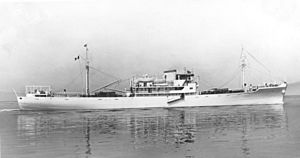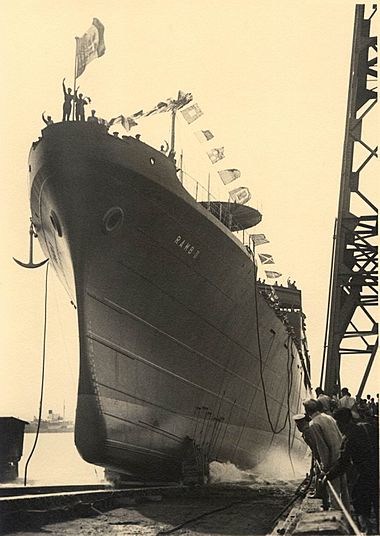Italian auxiliary cruiser Ramb II facts for kids
class="infobox " style="float: right; clear: right; width: 315px; border-spacing: 2px; text-align: left; font-size: 90%;"
| colspan="2" style="text-align: center; font-size: 90%; line-height: 1.5em;" | 
|} The Italian ship Ramb IIwas a special kind of boat called a banana boat. It was built in 1937, before World War IIbegan. This ship was designed to carry bananas, but it could also be turned into a warship if needed. During World War II, Ramb IIbriefly served as an auxiliary cruiser for the Italian Navy. Later in the war, it became a transport ship for the Imperial Japanese Navy.
Contents
| History | |
|---|---|
| Name |
|
| Owner | Italian Government |
| Operator | Regia Azienda Monopolio Banane |
| Builder | C.R.D.A., Monfalcone |
| Yard number | 1181 |
| Laid down | December 14, 1936 |
| Launched | June 7, 1937 |
| Commissioned | September 6, 1937 |
| Reclassified | Auxiliary cruiser, 1940 |
| Homeport | Genoa |
| Identification | |
| Fate | Scuttled by her crew in Kobe harbor, 8 September 1943 later refloated by Japanese, 1943 |
| Name | Ikutagawa Maru |
| Acquired | 1943 |
| Commissioned | 30 November 1943 |
| In service | 3 October 1943 |
| Stricken | 5 February 1945 |
| Identification | |
| Fate | Sunk, 12 January 1945 |
| General characteristics | |
| Type |
|
| Tonnage |
|
| Length | 383 ft 2 in (116.79 m) |
| Beam | 49 ft 9 in (15.16 m) |
| Depth | 24 ft 8 in (7.52 m) |
| Installed power | 1193 Nhp |
| Propulsion |
|
| Speed | 18 knots (21 mph; 33 km/h) |
| Capacity |
|
| Complement | 120 |
| Armament |
|
| Service record | |
| Part of: | Red Sea Flotilla |
Building the Ramb II
In the late 1930s, the Italian government needed a way to bring bananas from Italian Somaliland (a colony in Africa) to Italy. They ordered four special ships that could carry a lot of fruit and travel long distances without stopping.
These four ships were called "refrigerating vessels" because they had special cooling systems to keep the bananas fresh. They were managed by a company called Regia Azienda Monopolio Banane (RAMB).
Ramb II was one of these ships. It was built at a shipyard in Monfalcone, Italy.
- Work on Ramb II started on December 14, 1936.
- It was launched into the water on June 7, 1937.
- It was ready for service on September 6, 1937.
These ships were quite modern for their time. They could carry about 2,400 tons of cargo. They also had space for twelve passengers. Passengers had comfortable rooms, including a luxury apartment, and their own private deck. There was also a dining room and two verandas. The passenger areas even had air conditioning!
The Ramb II was about 117 meters (383 feet) long and 15 meters (49 feet) wide. It was powered by two large diesel engines that turned two propellers, allowing it to travel at a speed of up to 18 knots (about 33 kilometers per hour or 21 miles per hour).
An important feature was that these ships were built so they could be easily changed into auxiliary cruisers. This meant they had space on deck to add four large 120 mm (4.7-inch) cannons if they were needed for war. The cannons and other military equipment were stored in different ports, ready to be installed.
Ship's Service History
For two years, before World War II started, Ramb II did its job of transporting bananas. It sailed from Italian Somaliland to Italian cities like Venice, Naples, and Genoa. On its return trips, it carried other goods back to Mogadishu. Sadly, on August 7, 1938, there was an explosion on board the ship while it was in Trieste, and eight men died.
Becoming a Warship
On April 9, 1940, the Italian Navy (called the Regia Marina) took control of Ramb II. They converted it into an auxiliary cruiser at a port called Massawa in Eritrea. After this change, the ship was armed with:
- Four 120 mm (4.7-inch) cannons
- Two 13.2 mm Breda anti-aircraft guns (to shoot down planes)
When Italy entered World War II on June 10, 1940, Ramb II became part of the Italian Navy's Red Sea Flotilla. However, Ramb II never actually went out on missions as a warship. It stayed docked in Massawa. This was because there weren't many enemy merchant ships to attack, and the British Navy had a strong presence in the Red Sea.
Escape to Japan
By late 1940, the war in North Africa was going badly for Italy. It became clear that Italian forces in Italian East Africa would soon be cut off. Fuel supplies were running low. To prevent their ships from being captured, the Italians planned to send as many as possible to neutral Japan or to areas controlled by their ally, France. Ramb II was one of the ships chosen to make this long journey to the Far East.
Ramb II left Massawa on February 22, 1941. It sailed through dangerous waters, avoiding British ships and planes. Another Italian ship, Ramb I, was sunk by a British cruiser during this journey. But Ramb II managed to cross the Indian Ocean and safely reached Kobe, Japan, on March 23, 1941.
The Italian government wanted to use Ramb II to attack British merchant ships in the Indian Ocean. However, Japan was neutral at the time and didn't want a warship operating from its ports. So, the day after arriving, Ramb II sailed into international waters, removed its weapons, and then returned to Japan.
In May 1941, the ship's name was changed to Calitea II. It was then used as a cargo ship. In December 1941, the Japanese government hired Calitea II as a cargo vessel, but it still had its Italian crew.
In September 1942, the ship was officially hired by the Imperial Japanese Navy as a supply ship. It had more refrigeration equipment added. Calitea II began carrying supplies and troops around Southeast Asia. On August 24, 1943, it returned to Kobe for repairs.
On September 8, 1943, Italy signed an agreement to stop fighting in the war (called the Armistice of Cassibile). To prevent the ship from falling into Japanese hands, the Italian crew of Calitea II sank their own ship in Kobe harbor.
In Japanese Service
Even though the Italian crew sank Calitea II, the Japanese refloated it. On October 3, 1943, they renamed the ship Ikutagawa Maru and officially registered it as an auxiliary transport ship on November 30, 1943. After repairs, it joined the Japanese Navy's Southwest Area Fleet.
Ikutagawa Maru began its first mission under the Japanese flag on January 7, 1944. It was part of a convoy (a group of ships traveling together) with other merchant vessels and escort ships. On January 10, 1944, a US submarine, USS Seawolf, attacked the convoy and sank three ships.
Throughout 1944, Ikutagawa Maru continued to carry supplies to various island ports in Southeast Asia. On November 4, 1944, it briefly ran aground (got stuck on the seabed) but managed to free itself.
On January 12, 1945, during a large attack by US Navy airplanes (part of "Operation Gratitude"), Ikutagawa Maru was sunk along with several other ships. This happened near Saigon (now Ho Chi Minh City) in Vietnam.


